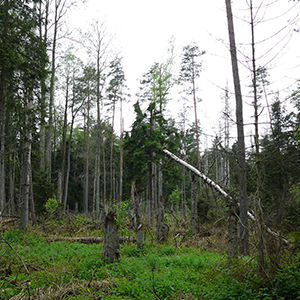Ecological impact of logging in the Białowieża Forest extends far beyond logged areas

A team of researchers from the Swedish University of Agricultural Sciences, Siedlce University and the Mammal Research Institute Polish Academy of Sciences, has provided a first objective estimate of the extent of logging (since 2015) in the renowned Białowieża Forest. This forest is the last remaining area of lowland temperate forest with a primeval character in Europe and is a UNESCO World Heritage and Natura 2000 site.
The logging was carried out by the State Forests Holding to address an outbreak of spruce bark beetle Ips typographus. In autumn 2017, the logging was halted following a decision by the European Court of Justice. The team, led by Associate Professor Grzegorz Mikusiński, also quantified the impact of logging.
It determined that the ecological impact of logging extends far beyond the logged areas by modifying the landscape structure and affecting ecosystem functioning on a landscape scale. The team has provided recommendations for the future management of Białowieża Forest to mitigate these human-induced impacts. The study was recently published in the scientific journal Biological Conservation.
The authors used satellite images to detect and analyse changes in land cover and thereby quantify the area of Białowieża Forest that was logged between July 2015 and June 2018. This analysis identified that at least 675 ha, including 229 ha of old growth stands was logged. Since every animal and plant species reacts individually to logging and human-disturbance, the team used buffer zones guided by available scientific literature to estimate the ecological impact. With a buffer of 100 meters from the edge of logged forest patches, it was estimated that at least 4 073 ha of forest was affected. Logging also resulted also in a 26% increase in fragmentation of the entire Natura 2000 area.
The findings suggest that the ecological impact of logging extends beyond the logged areas by modifying the landscape structure and affecting ecosystem functioning at a landscape scale. The logging effectively 'perforated' the forest and damaged the conservation value of this precious area.
To avoid further degradation, the authors urge that the logged areas should be allowed to naturally regenerate with trees to create natural stands that are better adapted to the current climatic conditions. The authors also strongly recommend that the national park should be extended to embrace the whole of the Białowieża Forest. In addition to securing the natural functioning of this valuable ecosystem, enlarging the national park would allow for much better coordination of Białowieża Forest's management, including the development of ecotourism. The Białowieża Forest would then continue to serve as a source of invaluable knowledge in relation to the interplay of natural processes and biodiversity. This knowledge could then, in turn, be applied to other areas where the aim is to restore a naturally dynamic forest.
Publication
Mikusiński, G., Bubnicki, J.W., Churski, M., Czeszczewik, D., Walankiewicz, W., Kuijper, D.P.J. Is the impact of loggings in the last primeval lowland forest in Europe underestimated? The conservation issues of Białowieża Forest. Biological Conservation 227: 266-274.
https://doi.org/10.1016/j.biocon.2018.09.001
Contact persons
Dr. Grzegorz Mikusiński, Associate Professor
Department of Ecology, Grimsö Wildlife, Research Station
Swedish University of Agricultural Sciences (SLU)
Tel: +46 70 775 71 61, Grzegorz.Mikusinski@slu.se
Dr. hab. D.P.J. Kuijper, Associate Professor
Mammal Research Institute, Polish Academy of Sciences
Ul. Stoczek 1, 17-230, Białowieża , Poland
+48 512817766, dkuijper@ibs.bialowieza.pl
Press images
(May be published without charge in articles about this press release, please acknowledge the photographer)
Spruce bark beetle infestations increase the amount of standing and laying dead wood, and change tree stand structure and openness, which is beneficial for dead wood specialists, such as white-backed and three-toed woodpeckers and many threatened saproxylic insects. Photo: D. Kuijper
Logging leads to complete habitat destruction for many species. Photo: D. Kuijper
Grzegorz Mikusiński. Photo: Anna Lundmark


